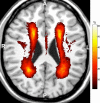White matter hyperintensities predict functional decline in voiding, mobility, and cognition in older adults
- PMID: 20374403
- PMCID: PMC3764600
- DOI: 10.1111/j.1532-5415.2009.02699.x
White matter hyperintensities predict functional decline in voiding, mobility, and cognition in older adults
Abstract
Objectives: To compare magnetic resonance imaging data with functional assessments of mobility, urinary control, and cognition to determine common or distinctive features in the distribution of brain white matter hyperintensities (WMHs) associated with functional decline and impairment.
Design: Baseline data from subjects aged 75 to 89 enrolled in a longitudinal study. Assessors and subjects were blinded to group assignment.
Setting: Healthy community-dwelling volunteers.
Participants: Ninety-nine subjects were enrolled using a balanced 3 x 3 matrix stratified according to age and mobility performance. Exclusion criteria were medication, systemic conditions, and neurological diseases that can compromise mobility.
Measurements: WMHs were identified using a semi-automated segmentation method, and regional burdens were assessed using a white matter parcellation atlas. Quantitative measures of mobility, urinary incontinence (UI) severity, and executive function and processing speed were obtained.
Results: WMHs occur predictably in predominantly periventricular areas. There were powerful correlations between total (tWMH) and regional (rWMH) WMH, with correlation coefficients of 0.5 to 0.9 for eight of 10 structures analyzed. tWMH predicted functional measures of UI, mobility, executive function, and processing speed nearly as well as the best regional measures. The total volume of WMHs independently explains 5% to 11% of the variability for mobility, UI severity, executive function, and processing speed and is a sensitive (0.7-0.8) predictor of functional decline. The odds of decline in each of the three functional domains was 1.5 to 2.4 times greater with each 1% increase in tWMH.
Conclusion: This work establishes the importance of brain WMH burden in three major geriatric syndromes. The findings support the inclusion of total WMH burden as a risk factor in the predictive and diagnostic criteria.
Figures

References
-
- Vermeer SE, Den Heijer T, Koudstaal PJ, et al. Incidence and risk factors of silent brain infarcts in the population-based Rotterdam Scan Study. Stroke. 2003;34:392–396. - PubMed
-
- Benson R, Guttmann C, Wei X, et al. Older people with impaired mobility have specific loci of perventricular abnormality on MRI. Neurology. 2002;58:48–55. - PubMed
-
- Baloh RW, Yue Q, Socotch TM, et al. White matter lesions and disequilibrium in older people. I. Case- control comparison. Arch Neurol. 1995;52:970–974. - PubMed
-
- Junque C, Pujol J, Vendrell P, et al. Leuko-araiosis on magnetic resonance imaging and speed of mental processing. Arch Neurol. 1990;47:151–156. - PubMed
Publication types
MeSH terms
Grants and funding
LinkOut - more resources
Full Text Sources
Other Literature Sources
Medical

